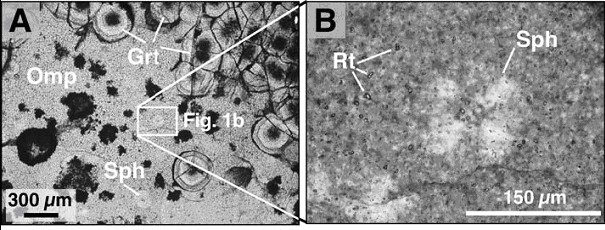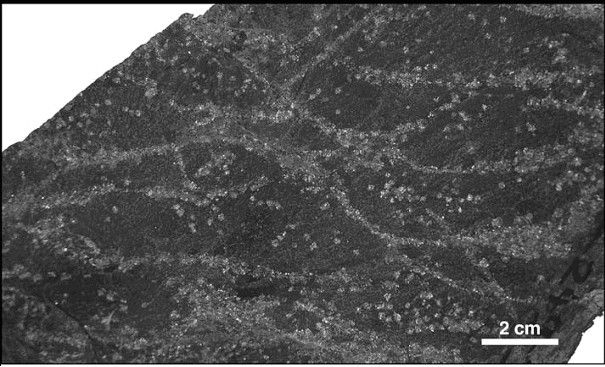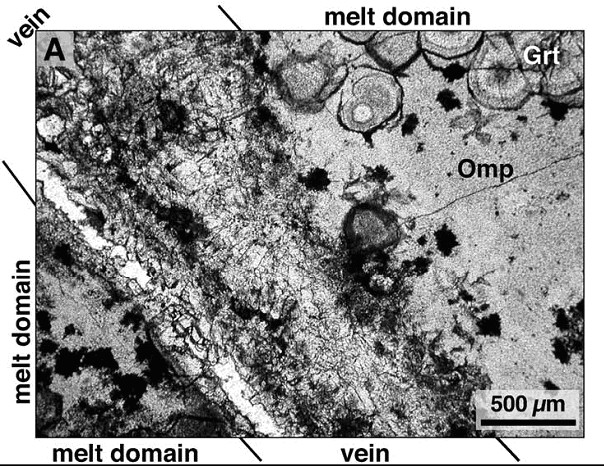 Web Content Display Web Content Display
Eclogite-facies pseudotachylyte formation and earthquakesINTRODUCTIONIntermediate-depth (70-300 km) earthquakes within subducting plates typically occur where dehydration reactions are anticipated to take place. Current debate centers on whether hydraulic fracturing and dehydration embrittlement are the main or even sole mechanisms causing intermediate-depth earthquakes, and whether hydraulic fracturing is necessary to produce the pathways for the required long-distance fluid flow. How or whether this fluid flow is linked to possible reactivation of normal faults and intermediate-depth earthquakes is not yet established (e.g., Kirby et al., 1996). Ogawa (1987) and Kanamori et al. (1998) proposed that, at least after initiation of rupture, frictional melting in slabs during faulting promotes rapid shear failure, which is the origin of intermediate-depth earthquakes. Thereby, permeabilities for fluids may be generated (Bjørnerud et al., 2002). Field evidence of eclogite facies pseudotachylytes, the only indisputable geological evidence of paleo-earthquakes of intermediate depth, has until now only been documented at three localities of the Norwegian Caledonides, i.e. within the deeply subducted continental root of a mountain belt. Their existence indicates that frictional melting is possible under low-temperature conditions at depths of 60-70 km. Here we describe textural features of eclogites from a fossil subducted oceanic plate in Zambia (John et al., 2003) that resemble those found in rapidly quenched volcanic melts. We interpret these features as evidence for former frictional melts, i.e., pseudotachylytes. TEXTURESPorphyroblastic garnet occurs in an extremely fine-grained matrix of omphacite (Fig. 1A). Omphacite spherulites (Fig. 1B) point to fast mineral growth in a viscous and homogenous medium, i.e. a melt. Ca sector zoning in garnet also indicates fast growth. These textures can be attributed to crystallization processes of eclogite facies minerals in melts. The petrologic evidence for fast mineral growth from quenched melt and the low ambient temperatures during eclogitization (~ 640°C; John and Schenk, 2003) suggest frictional melting. High Jadeite contents in the omphacite spherulites and the coexistence of garnet point to melt quenching under elevated eclogite facies conditions, i.e. near peak metamorphic conditions.
Fig. 1A: Part of a former melt domain, now consisting of large garnet (Grt) in fine-grained matrix of omphacite (Omp) and tiny rutile needles (not indicated). Slightly brighter omphacitic spherulites (Sph) occur dispersed in matrix. B: Magnification of A under crossed nicols. Matrix rutile (Rt) and omphacite are 2-3 m. Spherulite in center shows characteristic extinction cross (from John & Schenk 2006).
Fig. 2: Eclogite crosscut by eclogite facies garnet-bearing veins (from John & Schenk 2006) VEIN FORMATIONFine-grained eclogite (Fig. 2) is cut by a vein network, along which garnet nucleated preferentially, whereas the matrix in between is dominated by omphacite. The vein-forming fluid caused a chemical change, forcing the concentration of garnet along the veins. This indicates that the fluid infiltration immediately followed the grain-size-reducing process, at least fast enough to avoid a more homogeneous distribution of the eclogite-forming minerals. Vein garnet shows prograde chemical growth zoning and contains omphacite inclusions. This indicates continuous garnet and omphacite growth during slightly increasing P-T conditions, i.e., vein formation continued during ongoing descent of the rocks. The similar chemical composition of minerals in melt- and vein domains (Fig. 3) suggests that vein formation directly followed the crystallization of melt.
Fig. 3: Eclogite-facies vein cutting through melt domain. Note sharp and corrosive interface interface between vein and melt domain (from John & Schenk 2006). CONCLUSIONSWe envisage a scenario in which a metastable gabbro transformed directly to an eclogite due to the seismic event and the following fluid infiltration. A metastable gabbro as protolith can explain why in the pseudotachylytes all precursor fragments were razed and an in situ total rock melting occurred. The petrologic record in the eclogites implies that first, a seismic failure occurred within the descending gabbroic rocks, during which pseudotachylyte melt domains and cataclasites formed and hydrous fluids infiltrated along the associated faults. This chronology implies that seismic failure with frictional melting occurred in a subducting oceanic crust, at least in the depth interval where eclogitization can take place. Furthermore, it implies that regions of seismic faulting became preferred higher permeability zones for subsequent fluid infiltration. Once rupture begins in a dry metastable oceanic gabbro, frictional melting can promote intermediate-depth earthquakes under eclogite facies conditions and this seismic event can produce permeabilities for external fluids. The Zambian eclogites and their earthquake-induced veins are interpreted to represent relict fluid pathways through subducted oceanic crust and to provide direct evidence of channelized and reactive fluid flow within a slab (see John and Schenk, 2003; John et al., 2004). We speculate that intermediate-depth earthquakes may be of general importance for triggering and enabling channelized fluid flow through the slab feeding the mantle wedge with the fluid that induces arc magmatism. |
 Events Events
Kieler Wissenschaftler fühlen den 'Puls der Erde' Wie funktioniert die Recyclingmaschine der Erde?Nach elf Jahren endet der Kieler Sonderforschungsbereich 574 zu Subduktionszonen Final colloquium of SFB 574 Teilprojekt ÖffentlichkeitsarbeitMEERESFORSCHUNG FÜR MICH UND DICH |
|
©SFB574 // Wischhofstrasse 1-3 // D-24148 Kiel // T. +49 (0)431 600 1413 // elange [AT] geomar.de








